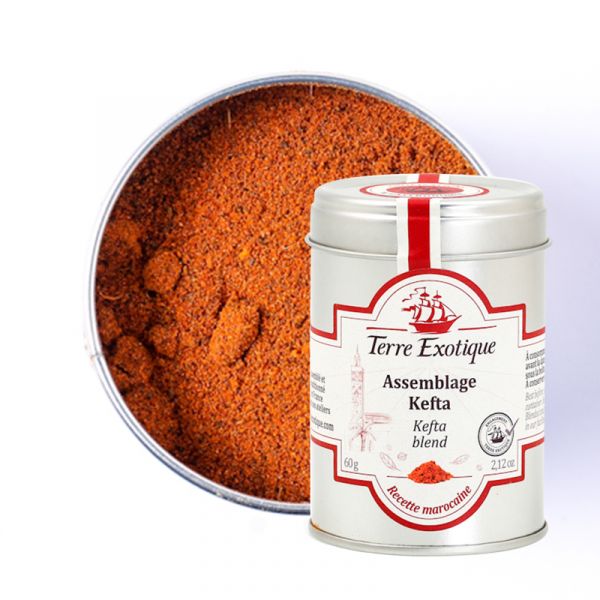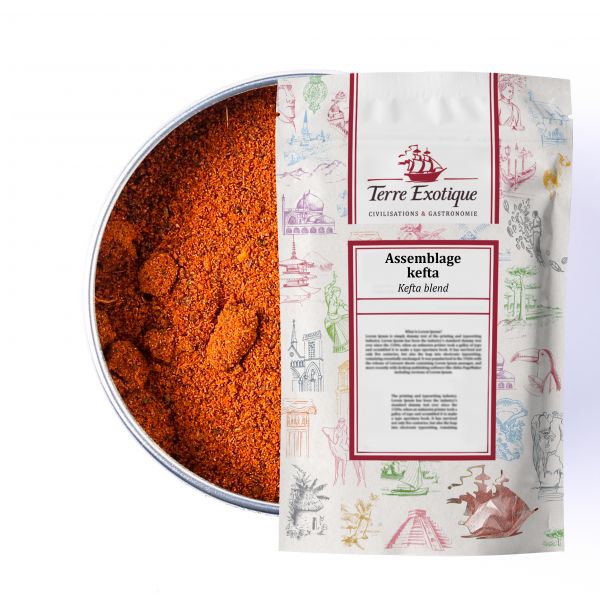



How to Use the Kefta Blend?
Our recipe ideas for using the Kefta blend in your kitchen:•Kefta meatballs: add 1 tablespoon of Kefta blend to your minced meat (find the complete recipe below);
•Vegetable stir-fry with Kefta flavors: add 2 teaspoons of Kefta blend to your vegetables during cooking;
•Kefta-style risotto: add 1 teaspoon of Kefta blend to your rice during cooking;
•Marinated chicken with Kefta spices: marinate your chicken with 1 tablespoon of Kefta blend and a drizzle of olive oil;
•Kefta spice sauce: add 1 teaspoon of Kefta blend to your homemade mayonnaise.
Find the recipe for Kefta burger, Tajine-style here
The Aromas of the Kefta Blend
The non-spicy, warm, and round notes of paprika give it character and exceptional spicy notes. Enhanced by the presence of garlic and ginger, which gives it a bit of pep, the Kefta blend is to die for!
What Spices Compose the Kefta Blend from Terre Exotique?
Garlic, whose botanical name is Allium sativum, comes from the Lily family. This perennial plant consists of a bulb formed of cloves wrapped in membranes. Garlic can reach up to one meter in height. The paprika used for this Kefta blend comes from the Zitava region in Slovakia, the northernmost European production region. With the botanical name Capsicum annuum, this plant is part of the Solanaceae family, just like peppers and chili peppers.Paprika has been traditionally cultivated in Slovakia for over 100 years. Paprika, also known as sweet pepper, originates from Colombia and the southern United States.
Our Indian ginger is harvested by hand. This tropical perennial plant, whose botanical name is Zingiber officinale, comes in the form of a tuber. This rhizome belongs to the same botanical family as cardamom, turmeric, and Ethiopian Kororima: the Zingiberaceae family. The Indian plant, after 10 months of growth, can reach up to 1 meter in height, but the part used in cooking is actually the underground part, the root, also called rhizome. Ginger requires significant heat to develop properly. In Europe, it is impossible to grow in your garden.
Cumin has the botanical name Cuminum cyminum and belongs to the Apiaceae family, just like parsley. Originating from the Near East, and mainly cultivated in the Mediterranean basin, cumin was initially a spice for smoking, then it was used to prepare dishes. The plant grows to about 30 cm in height. The seeds are harvested when ripe, in September or October. After harvesting, the stems are dried in the sun for two to three days and then beaten to detach the seeds, which are the famous cumin seeds we know in cooking.
Black pepper from Madagascar is botanically known as Piper nigrum. It is the fruit of a climbing vine of the Piperaceae family. It grows on a tree with rough and cracked bark that facilitates its ascent, often up to four meters in height. Piper nigrum requires a tropical climate with high heat and humidity, as well as an alternation of shade and light to develop properly. Post-harvest handling will give the pepper its final color and flavors.
Where Does Kefta Come From?
Kefta refers to a dish composed of meatball made from minced meat. This traditional dish comes from North Africa and the Middle East. Some stories place its origin in Algiers, where it is called Kofta Hassan Pacha. This dish, served especially during Ramadan meals, consists of Kefta meatballs topped with gratin mashed potatoes.| Allergen | Absence |
|---|---|
| Native country | FRANCE |
| Ingredients | paprika, ginger, cumin, black pepper, garlic. |
| Nutritional Info | VN Energie pour 100 g (energy for 100g) : 314 kcal / 1313 kJ VN Matière grasse (fat) : 14.3 g Dont acide gras saturés (of which saturated fat) : 2 g VN Glucides (carbohydrate) : 33.7 g Dont sucres (of which sugars) : 10.5 g VN Protéines (protein) : 14.1 g Vn Sel (salt) : 0.4 g |
| TRACES EVENTUELLES D'ALLERGÈNES | céleri, sésame, moutarde, fruits à coques. |
 Français
Français 